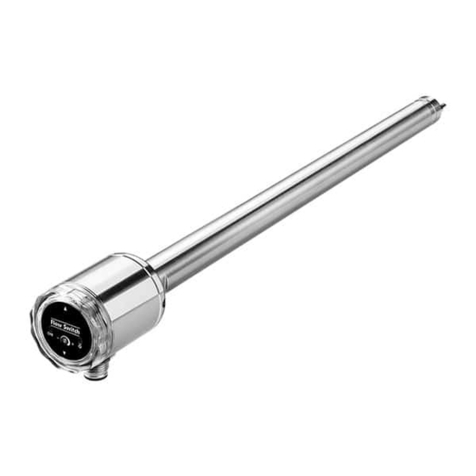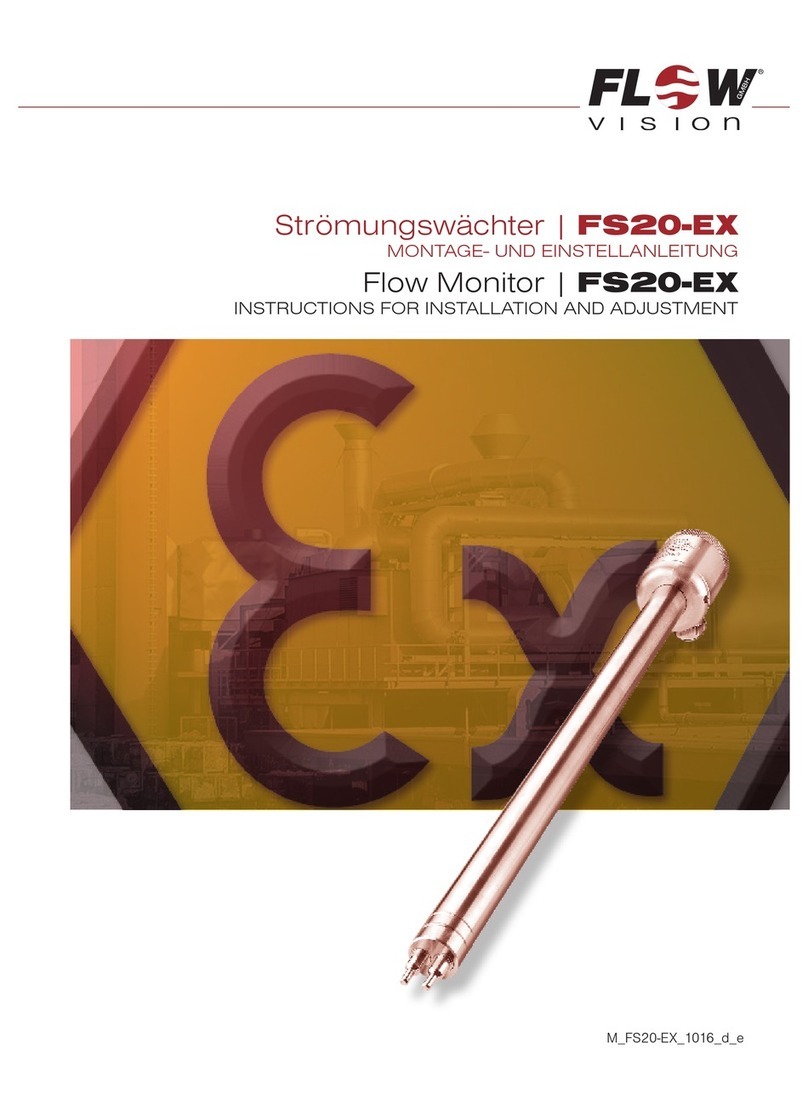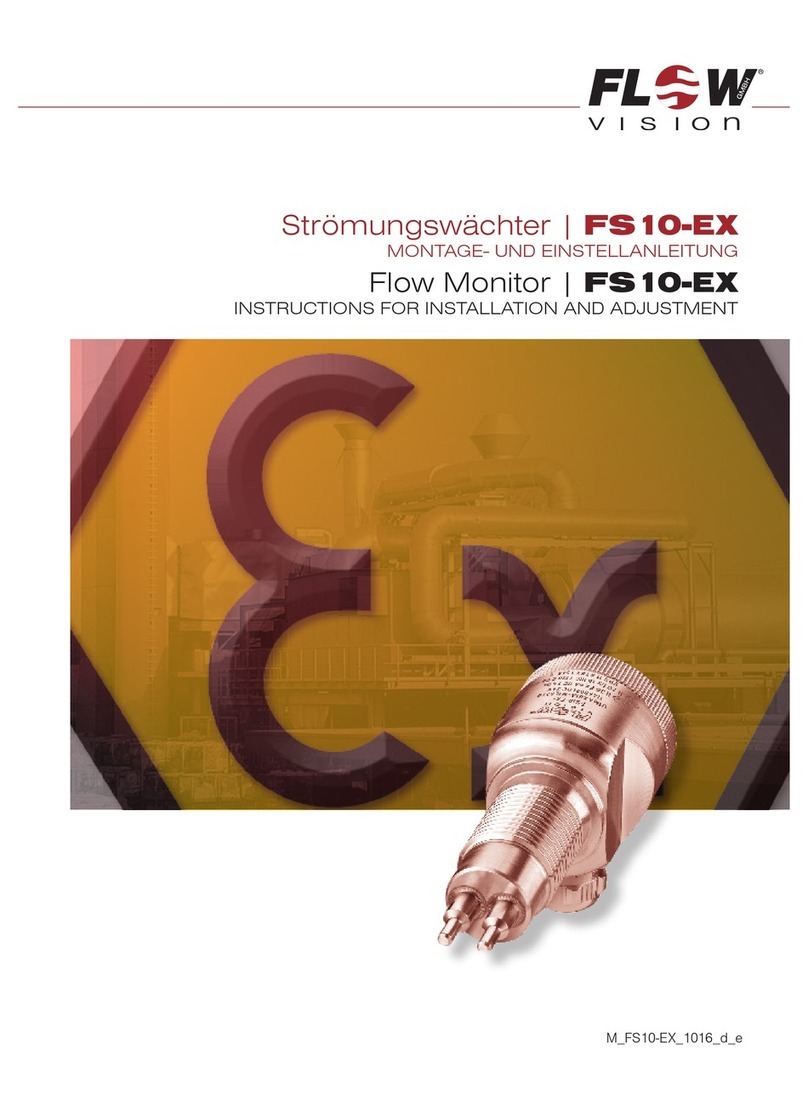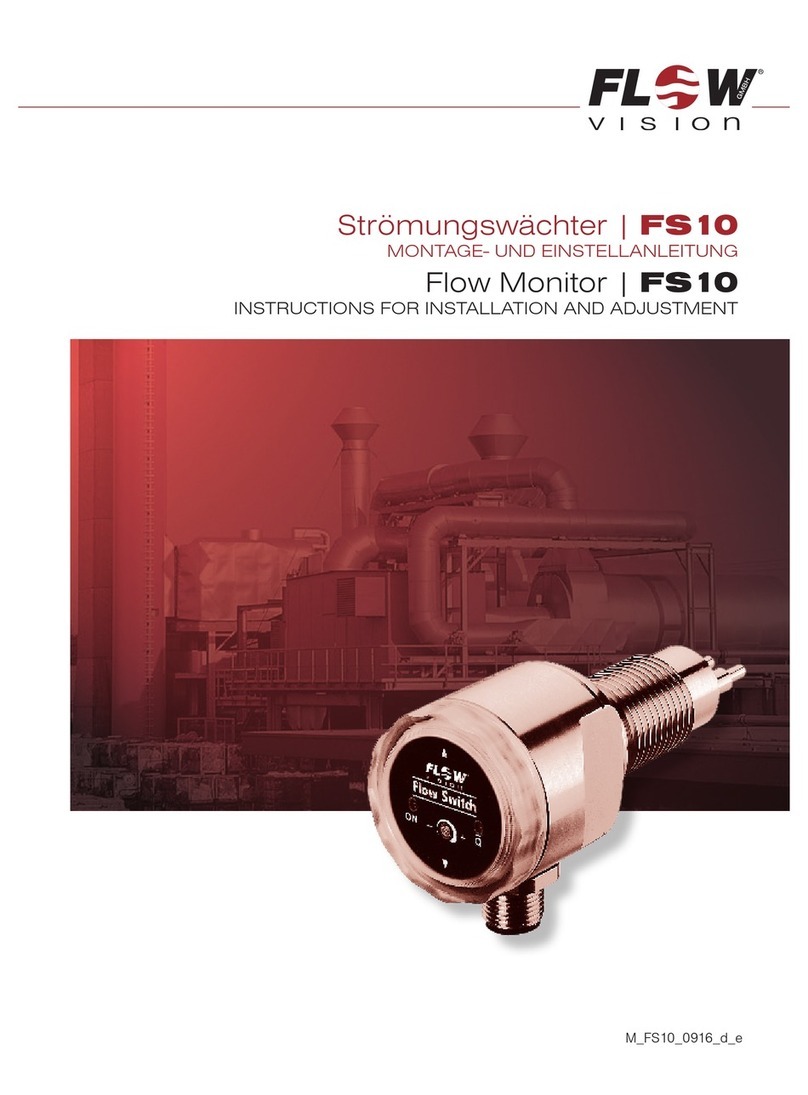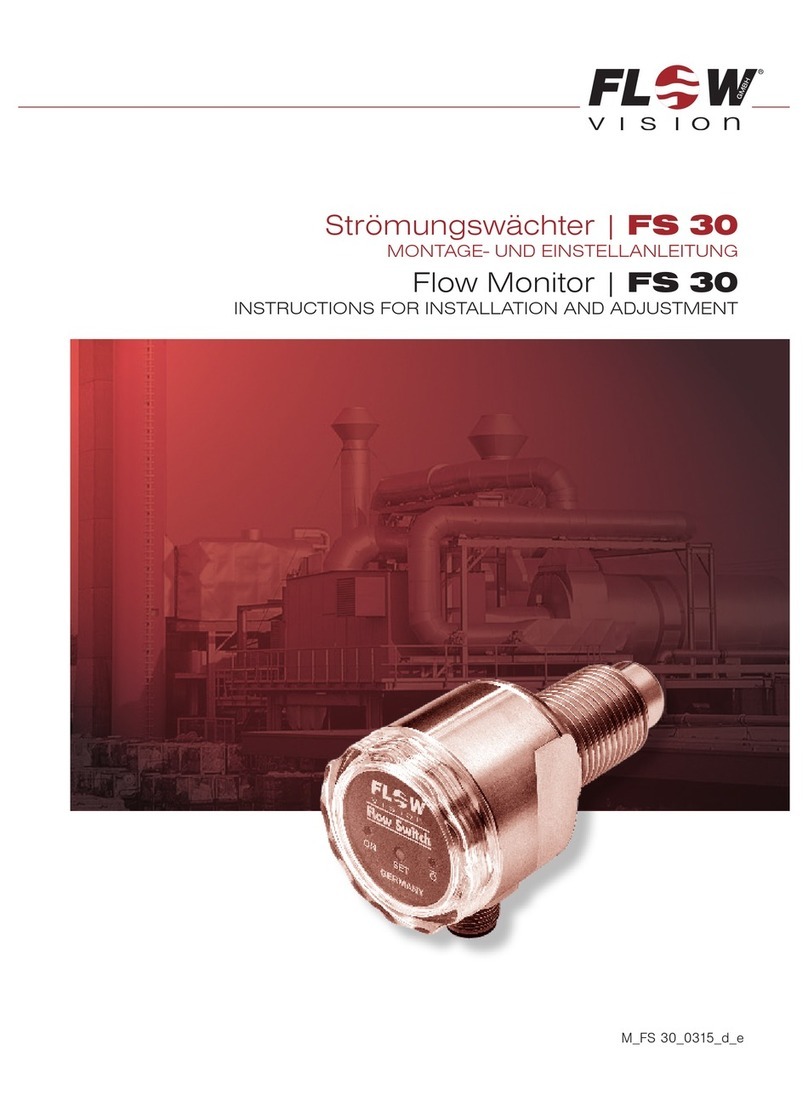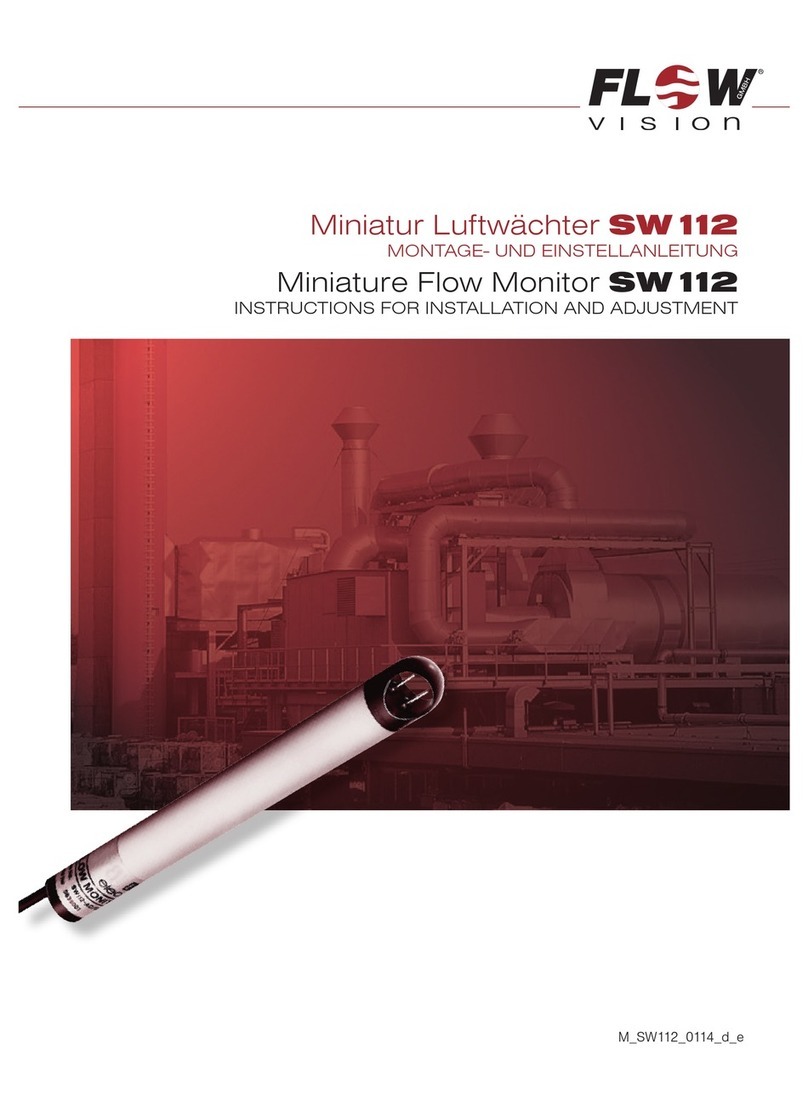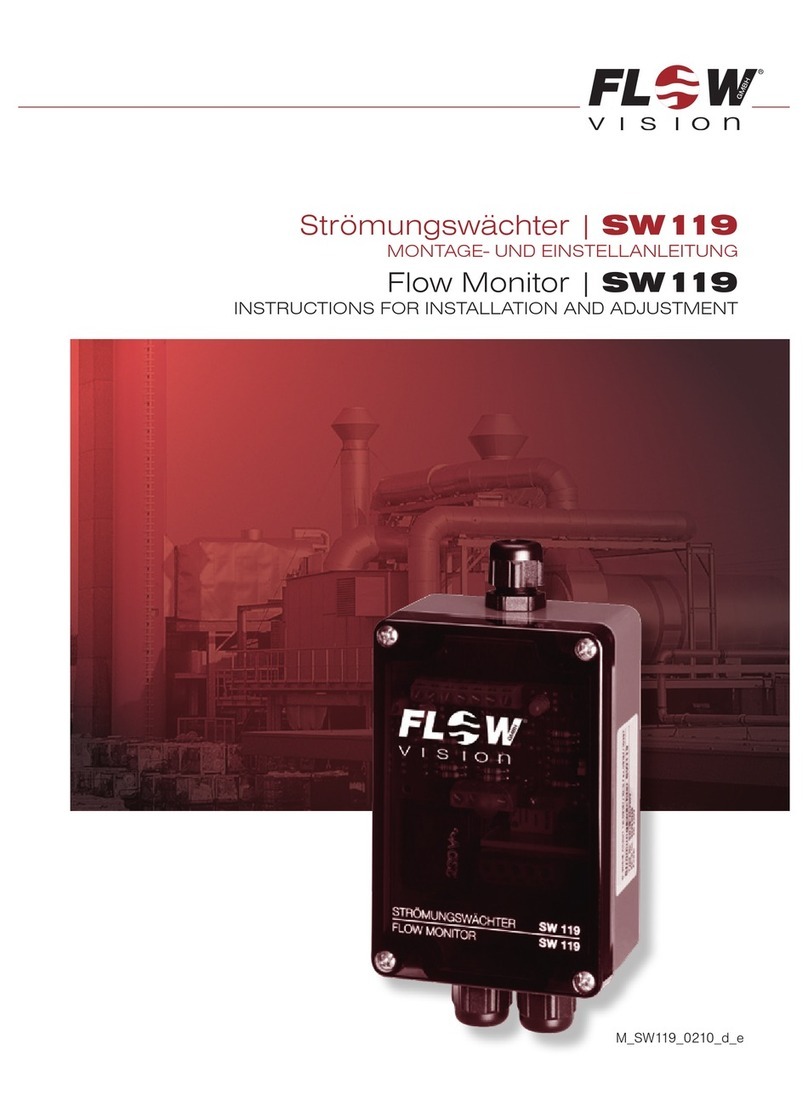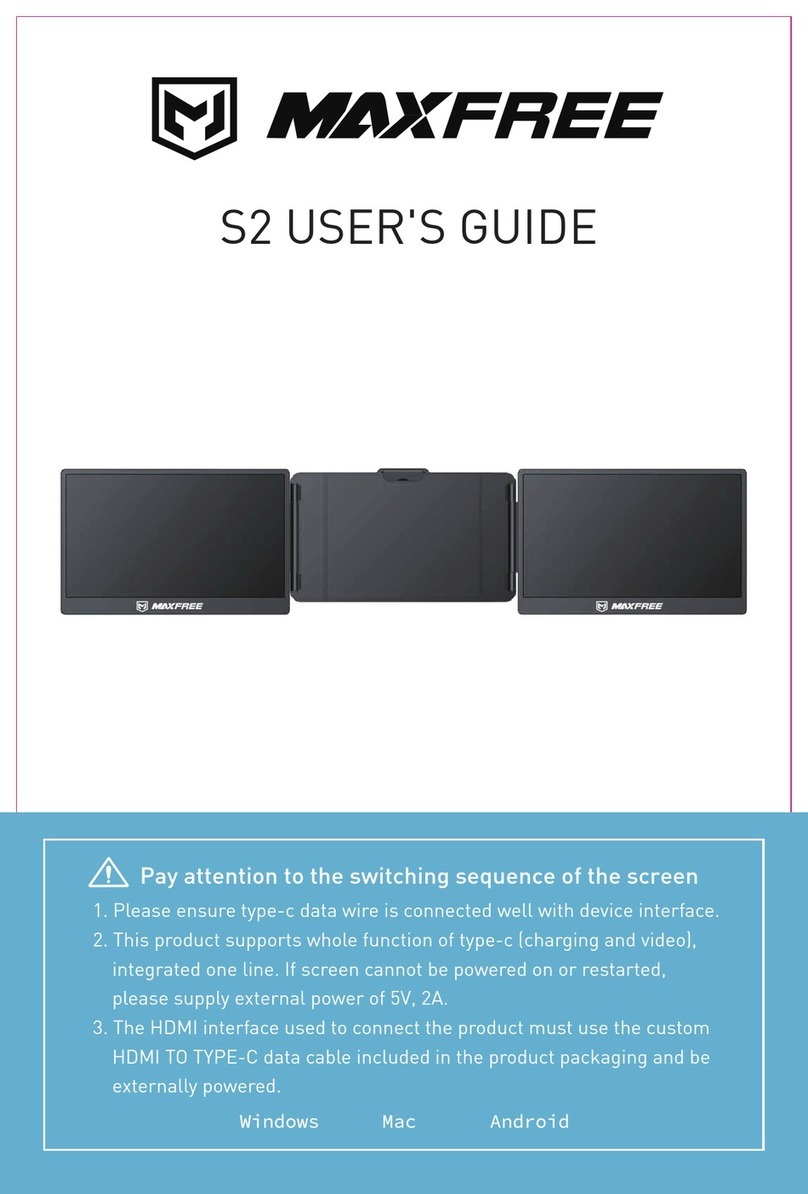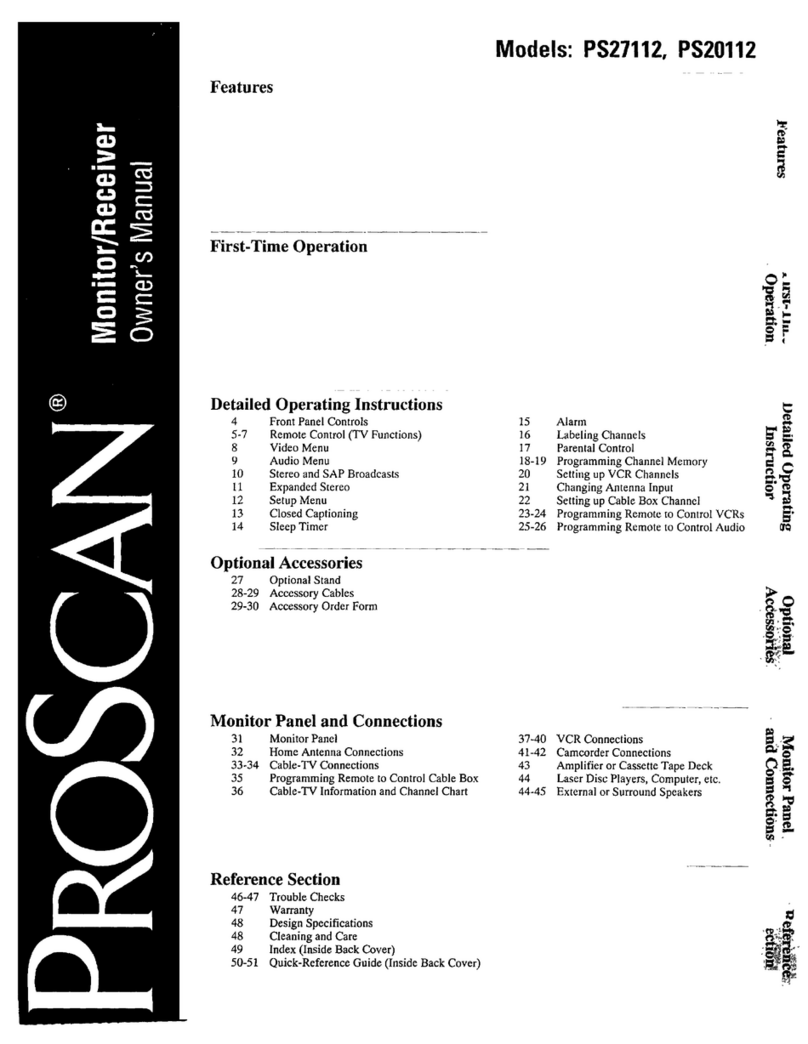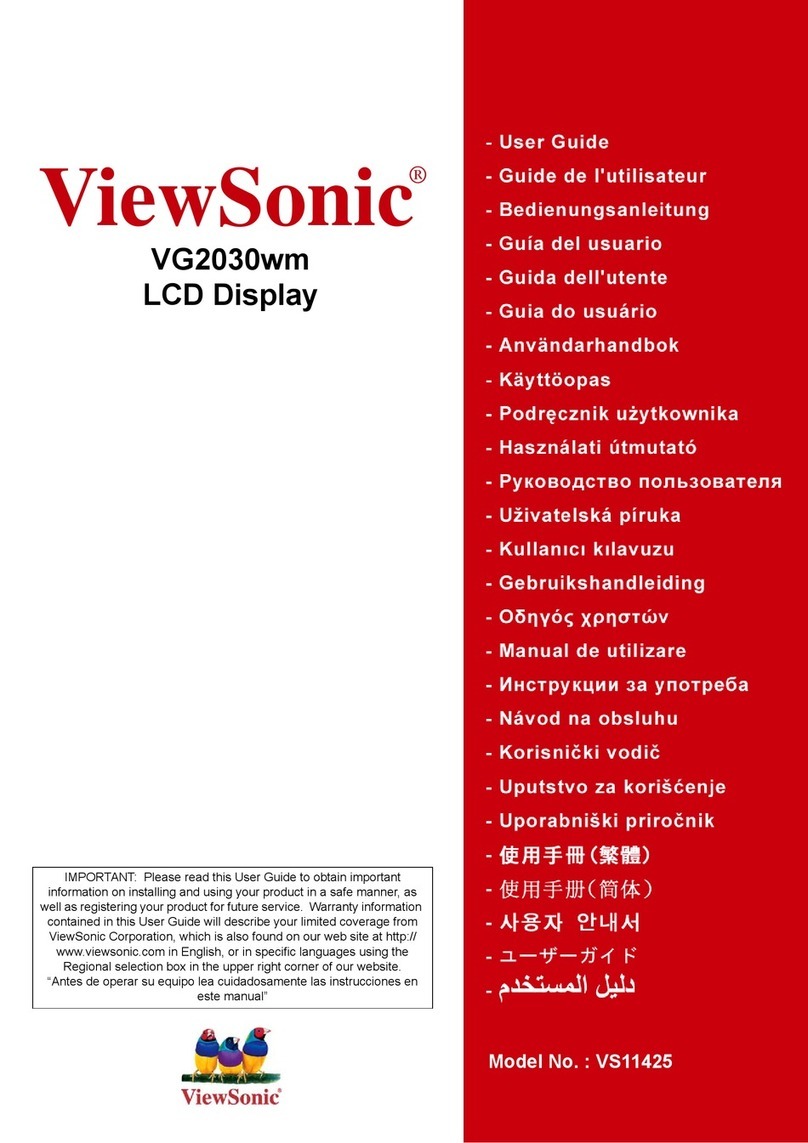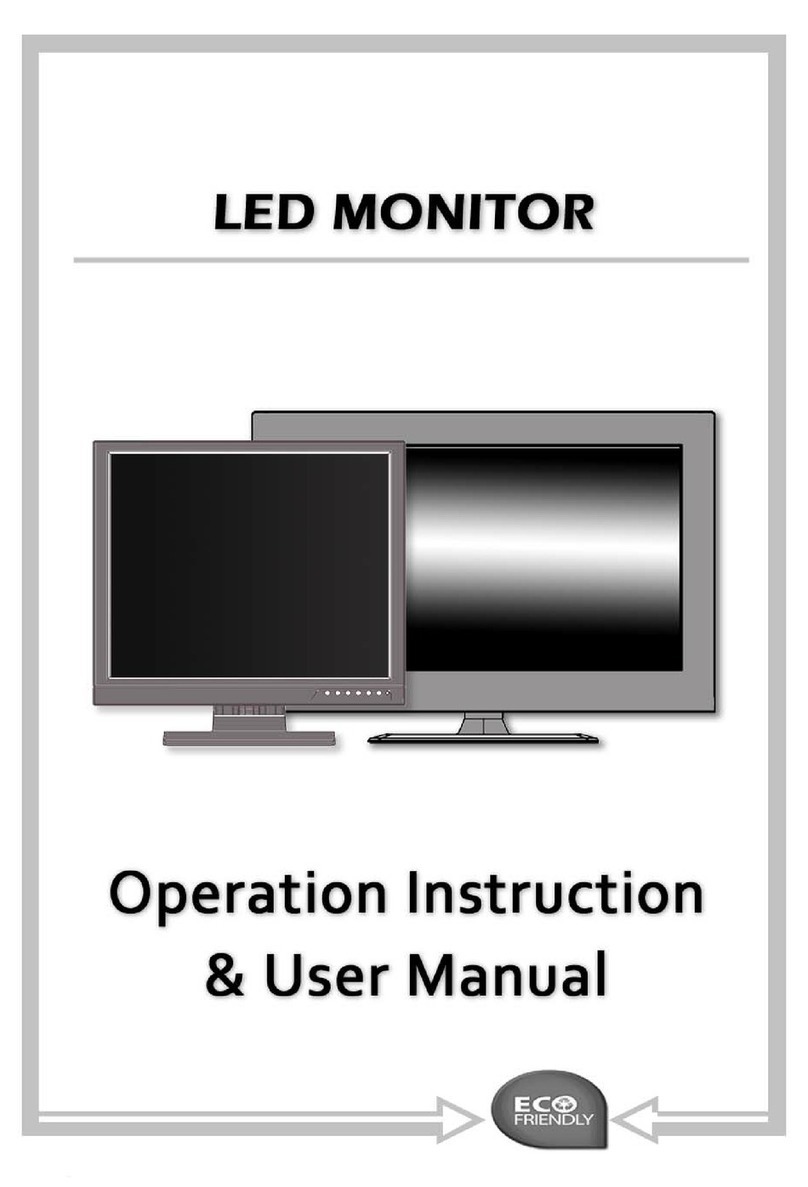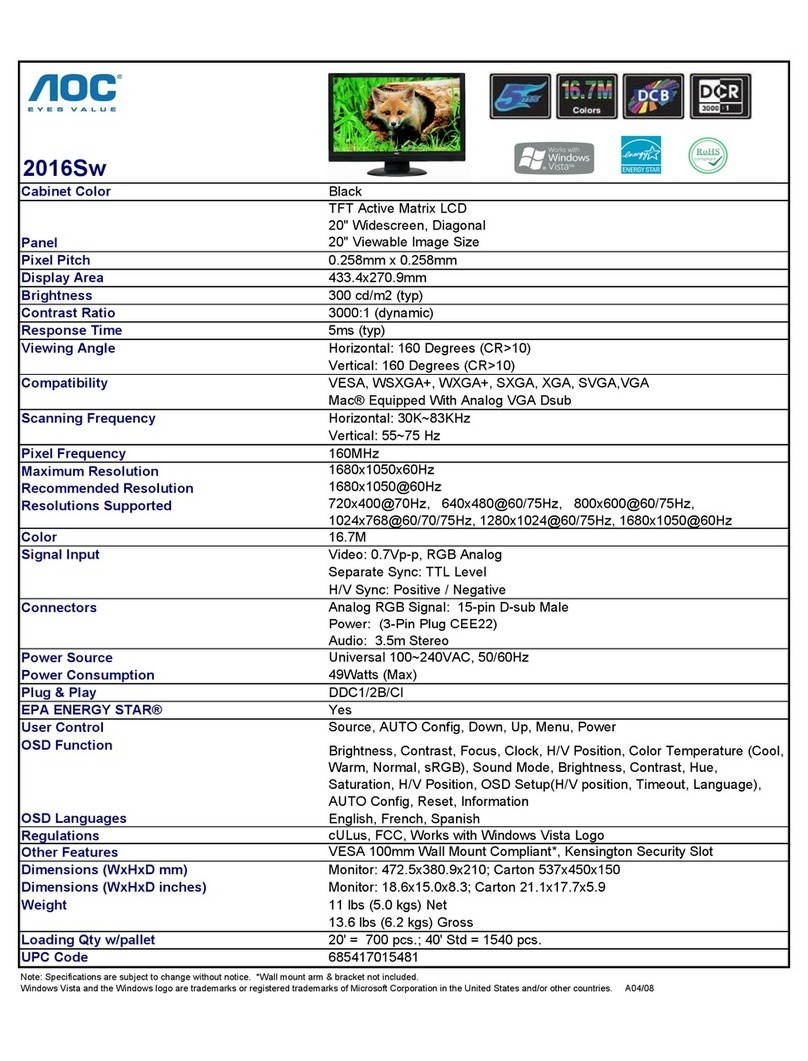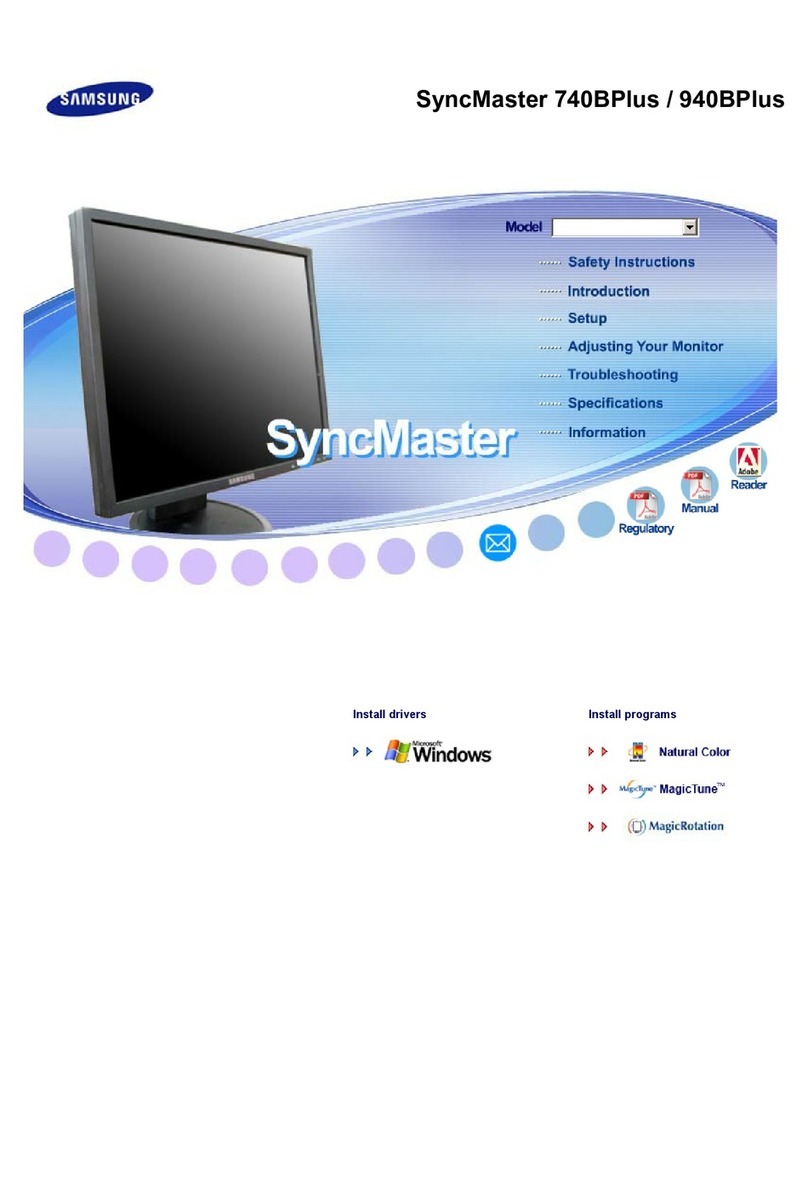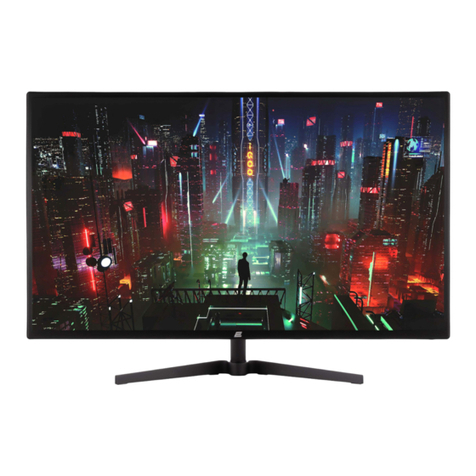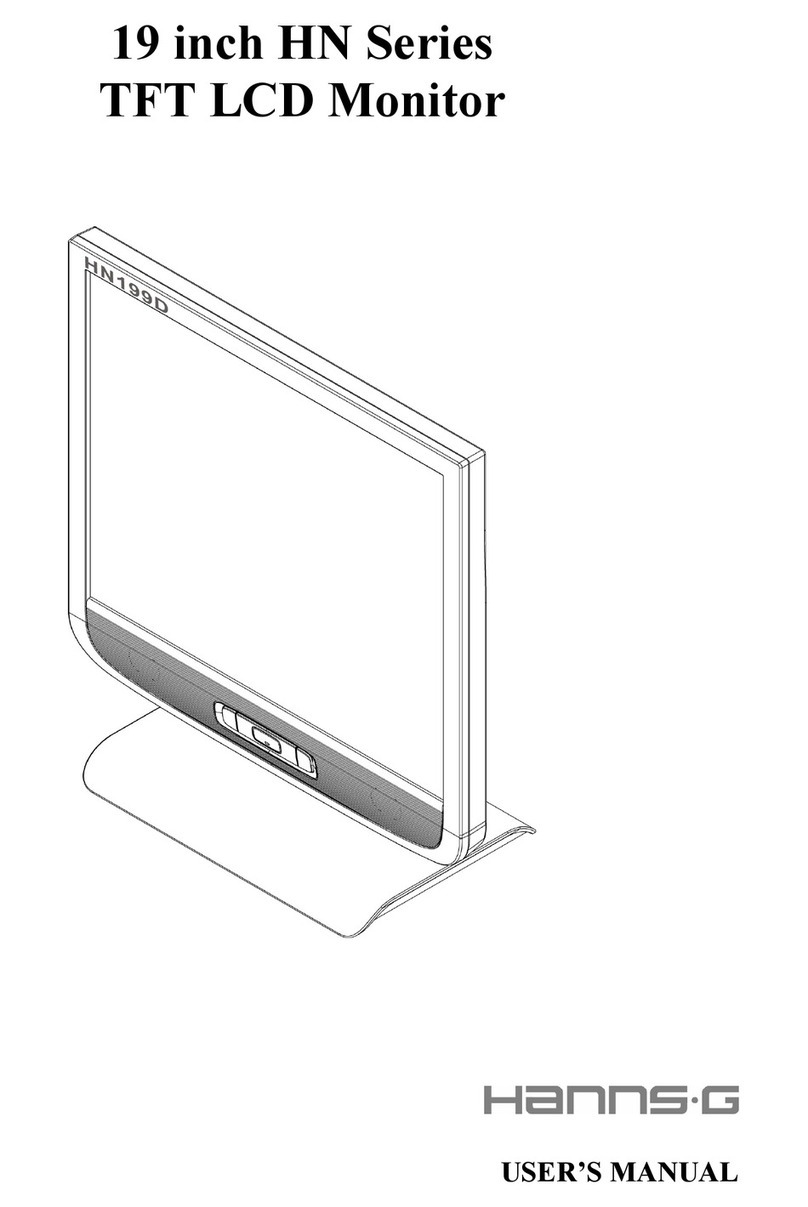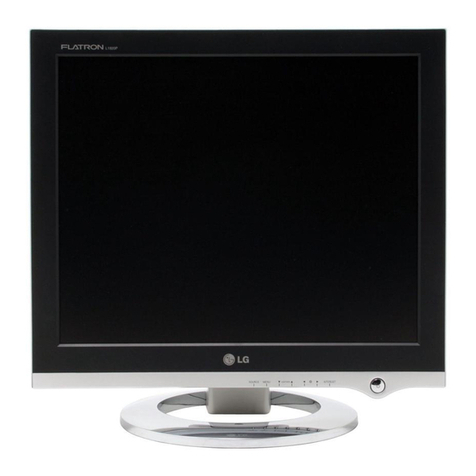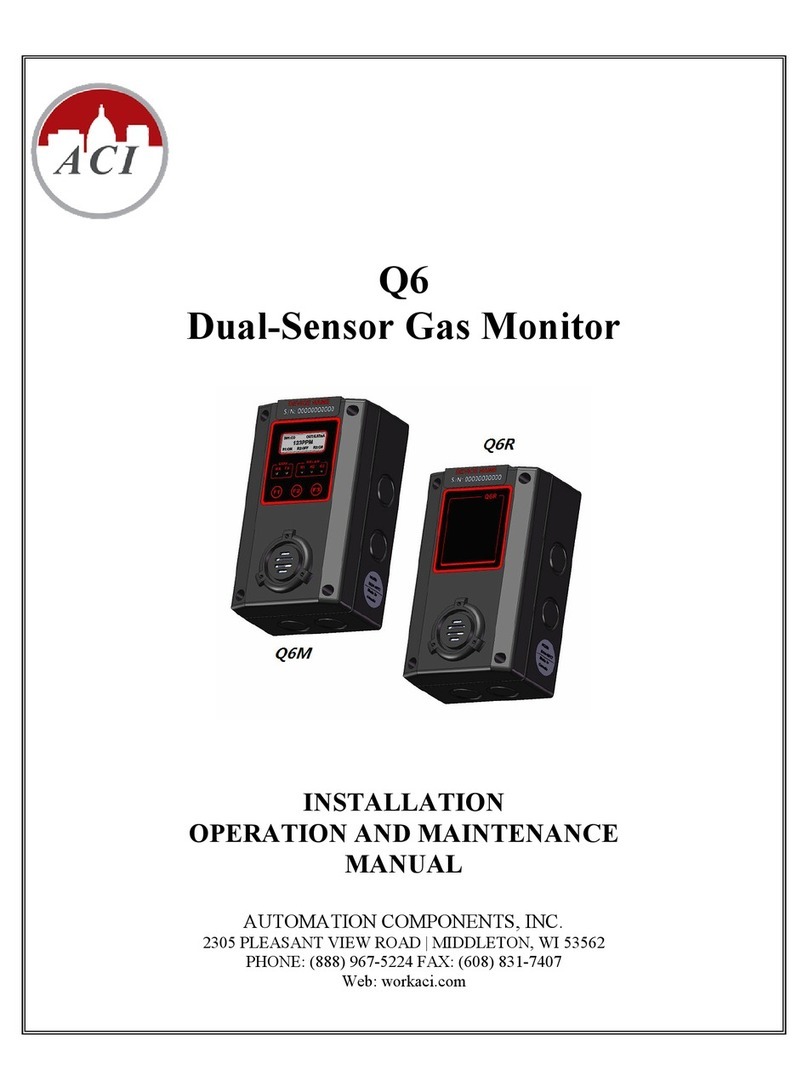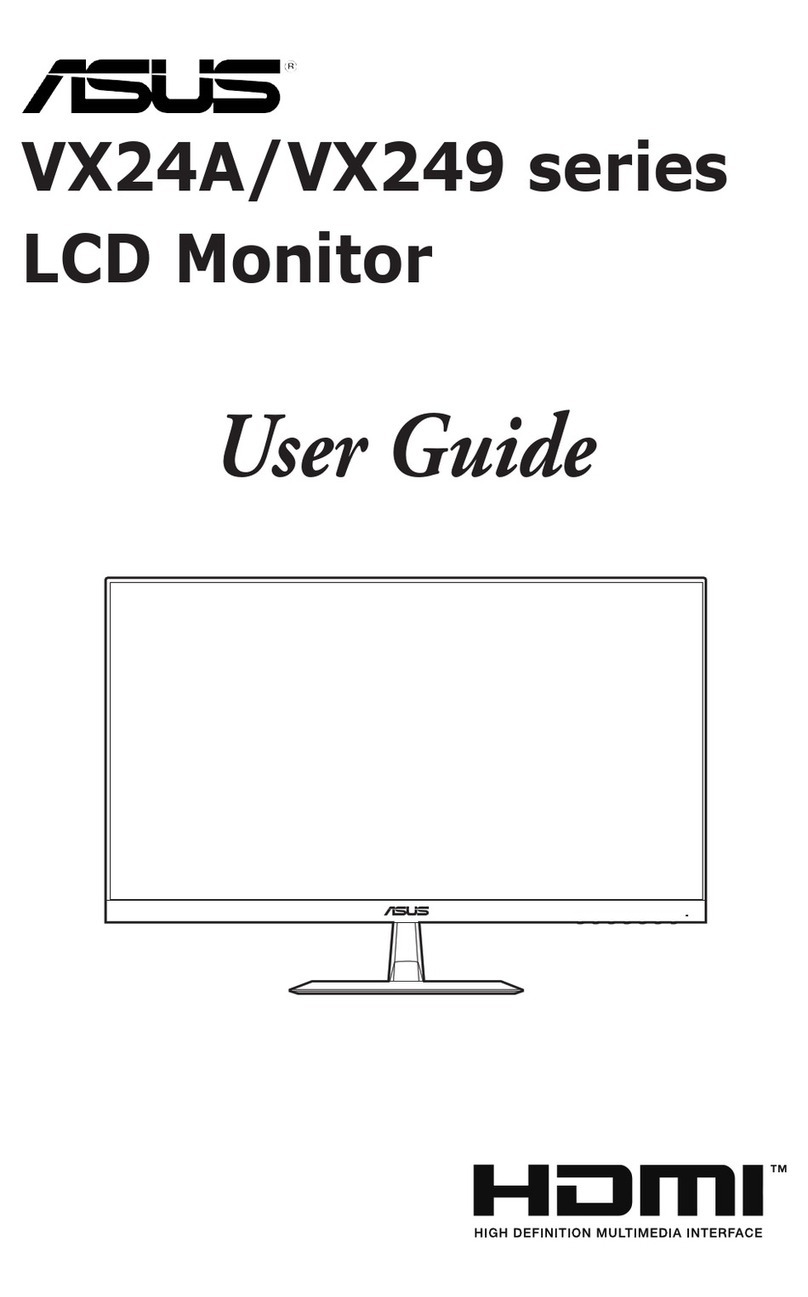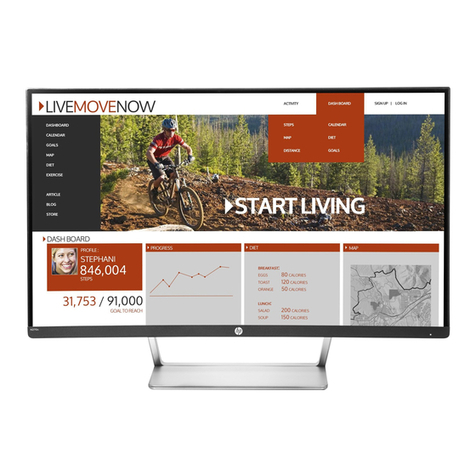Flow vision SW118 Guide

SW118
SW118
M_SW118_0210_d_e

GMBH
S W 11 8
Please follow these installation, connection and
adjustment instructions carefully. Failure to comply
with these instructions or misuse of this equipment
will void your warranty coverage.
Equipment installation, connection and
adjustment by qualified personnel only!
Important
Please follow these instructions carefully. Failure to
comply, or misuse of this equipment, could result
in serious damage both to the equipment itself and
to the installation. Flow Vision is unable to accept
responsibility for customer or third party liability,
warranty claims or damage caused by incorrect
installation or improper handling resulting form
non-observance of these instructions.
Diese Anleitung unterstützt Sie beim Einbau,
Anschließen und Einstellen des Strömungs-
wächters.
Die Garantie erlischt bei unsachgemäßer
Handhabung sowie bei Geräte-Demontagen, die
nicht in dieser Anleitung beschrieben sind.
Für mechanische oder elektrische
Beschädigungen als Folge unsachge-
mäßer Handhabung sowie deren mög-
liche Folgeschäden wird keine Haftung
übernommen.
Sicherheitshinweis
Eine Nichtbeachtung der Montage- und
Bedienungsanleitung kann zu erheblichen Schäden
am Gerät und an der Anlage führen. FlowVision
übernimmt gegenüber Kunden oder Dritten keine
Haftung, Gewährleistung oder Garantie für Mängel
oder Schäden, die durch fehlerhaften Einbau oder
unsachgemäße Handhabung unter Nichtbeachtung
der Montage- und Bedienungsanleitung verursacht
sind.

GMBH
S W 11 8
BeschreiBung | Description
1 Description
This Flow Monitor is designed to monitor the ow
of liquids and gases. Important operational safety
and reliability enhancing features designed and
built into these units include:
•
Calorimetric ow monitoring, which avoids the
need for moving parts in the ow.
•
The desired MIN or MAX switch point is step-
lessly adjustable and is clearly indi cated by dual
colour LED (red/green).
•
Medium selector switch with three settings (water,
oil, air).
•
With either no delay, or with a 60 s switch-on
delay or 10 s change over delay.
1 Beschreibung
Der Strömungswächter wird zur Strö mungs über-
wachung von üssigen oder gasförmigen Medien
eingesetzt. Die folgenden Gerätemerkmale steigern die
Zuver lässigkeit und erhöhen die Betriebssicherheit:
•
Die Überwachung erfolgt - ohne mechanisch beweg-
te Teile - nach dem kalorimetrischen Prinzip.
•
Der gewünschte MIN- oder MAX-Schaltpunkt ist
stufenlos einstellbar und wird mittels Duo-LED
(rot/grün) signalisiert.
•
Mit einem Schalter kann die Mediumsart (Wasser,
Öl, Luft) gewählt werden.
•
Mit einstellbaren Verzögerungen: 60 s Einschalt-
ver zögerung oder 10 s Umschaltverzögerung.

GMBH
S W 11 8
technische Daten | technical Data
2 Technische Daten
Überwachungsbereich Strömung:
flüssige Medien min. 10 mm/s
max. 4 m/s
gasförmige Medien min. 0,5 m/s
max. 50 m/s
Zulässiger Temperaturbereich:
des Mediums -25 °C … +70 °C
der Auswerteelektronik -25 °C … +50 °C
Druckfestigkeit Messkopf:
100 bar/1450 psi
Ansprechzeit:
Wasser ca. 2 s *
Öl ca. 4 s *
Luft ca. 7 s *
* Verzögerungswerte gemessen bei Schalt-
punkt einstellung auf 1 m/s und einer Be triebs -
strömung von 2 m/s nach plötzlichem Strö-
mungs stillstand.
Schutzart:
Messkopf IP 67
Auswerteelektronik IP 65
Nennspannung:
AC 230 V (+10%/-15%)
AC 115 V (+10%/-15%)
AC 24 V (+10%/-15%)
DC 24 V ±10%
2 Technical Data
Flow rate range:
liquids 10 mm/s (0.39 inch/s) minimum
4 m/s (13.1 ft./s) maximum
gases 0.5 m/s (20 inch/s) minimum
50 m/s (164 ft./s) maximum
Temperature range:
of the medium -25 °C … +70 °C
(-13 °F to +158 °F)
of the control unit -25 °C … +50 °C
(-13 °F to +122 °F)
Pressure resistance of the monitoring head:
100 bar/1450 psi
Response delay:
water approx. 2 s *
oil approx. 4 s *
air approx. 7 s *
* Delay with the switch point set to 1 m/s (3.3
ft./s) and the flow rate at 2 m/s (6.6 ft./s),
after a sudden complete flow stoppage.
Degree of protection:
Monitoring head IP 67
Control unit IP 65
Input voltage:
AC 230 V (+10%/-15%)
AC 115 V (+10%/-15%)
AC 24 V (+10%/-15%)
DC 24 V ±10%

GMBH
S W 11 8
montieren | installation
FC
S
FC
S
FC
S
FC
Bei senkrechter Leitung: Bei waagerechter Leitung: Die Messfühler müssen neben-
Nur in Steigleitungen einbauen. Nur von unten einbauen. einander im Rohr liegen.
V
ertical pipelines: Horizontal pipelines : The two sensors (S) must be
Medium should be rising. Monitoring head should be side by side across the
mounted on the underside. direction of flow.
Fig. 1
3 Strömungswächter montieren
1 Überprüfen, ob der einzubauende Strö mungs-
wächter für das Strömungsmedium und die
vorhandene Betriebsspannung ausge legt ist.
2 Den Einbauort des Strömungswächters wie folgt
wählen (siehe Fig. 1):
a Um Strömungsturbulenzen an den Mess -
fühlern zu vermeiden, den Mess kopf nur
in gerade Rohrleitungen einbauen. Auf
aus reichenden Abstand zu Quer schnitts -
ände run gen und Rohr krüm mun gen achten.
Minimal erforderliche Einlauflänge 10 x D
und Auslauflänge 5 x D (nach DIN 1952).
(D = Rohrnennweite)
3 Monitoring head installation
1 Check that the ow monitor is suitable for the
medium to be monitored and for the available
supply voltage.
2 For best performance the monitoring head should
be installed in the pipeline in accordance with the
following conditions (see g. 1):
a The monitoring head should be installed
only in a straight section of piping. There
should be a distance of at least 10 pipe
diameters before the monitoring head and
5 pipe diameters after the monitoring head
before or after any bends and changes in
pipe diameter, to avoid any effects of turbu-
lence.

GMBH
S W 11 8
montieren | installation
b Bei senkrechter Leitung möglichst nur
in Steigleitungen einbauen, um falsche
Signale durch Luftpolsterbildung zu ver-
meiden.
c Bei waagerechter Leitung Strömungs-
wächter von unten einbauen.
d Um evtl. Funktionsstörungen auszu-
schließen sind energiereiche induktive,
kapazitive und hochfrequente Einstreu-
ungen zu vermeiden.
Hinweis:
Bei Gasen ist die Einbaulage bei senkrechter
und waagerechter Leitung beliebig.
3 Messkopf mit Rohrfitting vergleichen und
überprüfen, ob die beiden Messfühler (S) im
eingebauten Zustand im Strömungsmedium
liegen (siehe Fig. 1), ohne den Rohr leitungs-
querschnitt wesentlich zu verringern.
ACHTUNG!
• Mit einem Gabelschlüssel (SW 27) an den
Schlüsselansatzächen (FC) (siehe Fig. 1) hin-
ter dem Gehäuse und nicht mit dem Gehäuse
festziehen!
•
Strömungswächter mit entsprechendem Dich-
tungsmaterial in das vorgesehene Rohr fitting
einschrauben.
•
Die beiden Messfühler (S) müssen nebeneinander
im Strömungsmedium liegen.
Dies ist der Fall,
wenn die Schlüsselansatz ächen (FC) parallel
zur Rohrleitung stehen (siehe Fig. 1).
•
Beim Anziehen des Messkopfes die VDI Richtlinien
2230 für das Anzugsmoment un bedingt beach-
ten.
b In the case of vertical pipelines the moni-
toring head should be installed where the
flow is rising, if possible.
c For horizontal pipelines the monitoring
head should be mounted on the under-
side of the line (suspended).
d Avoid installing the monitoring head in
known areas of high electrical inductance,
capacitance, or high-frequency electro-
magnetic fields.
Note:
If gases are the medium to be monitored,
the mounting attitude of the monitoring head
is unimportant in either vertical or horizontal
pipelines.
3 The monitoring head should be screwed into
the pipeline far enough to ensure that the sen-
sors (S) are positioned fully in the flow (see
fig. 1). However, care should also be taken
that the monitoring head is not screwed in too
far, thus causing an undue restriction in the
pipe bore.
CAUTION!
•
When tightening the flow monitor please use the
flats provided (SW 27)
(FC)
and do not turn or
apply torque to the housing
(see g. 1)
.
•
It is important that thread sealing compound or
material of the correct type for the media is used
when fitting the monitoring head.
•
The two sensors (S) on the monitoring head must
be aligned side by side directly across the direc-
tion of flow. The sensors are cor rectly positioned
when the wrench flats (FC) are aligned parallel
with the pipeline (see fig. 1).
• Do not overtighten.

GMBH
S W 11 8
anschliessen | electrical connection
MIN oder/or MAX
Relaisausgänge
relay outputs
0 I
AC: L N
DC: + -
Netzanschluss
mains
1 2 34 5
0 = Überwachungsmedium ist im unzulässigen Bereich
medium to be monitored is in the inadmissible range
I = Überwachungsmedium ist im zulässigen Bereich
medium to be monitored is in the operating range
Relais unerregt dargestellt (LED rot)
relay shown de-energized (LED red)
Fig. 2
4 Anschließen
ACHTUNG!
•
Überprüfen, ob die Versorgungsspannung
mit der Nennspannung des Strömungs wäch -
ters übereinstimmt.
1 Gehäusedeckel abschrauben und entfernen.
2 Kabel für Netzanschluss und Relaisausgang
durch die Kabelverschraubung führen.
3 Den Netzanschluss an den Klemmen 1 und
2 und den Relaisausgang an den Klemmen
3 … 5 anschließen (siehe Fig. 2).
4 Kabelverschraubung zur Zugentlastung der
Kabel handfest anziehen.
5 Versorgungsspannung anschließen.
4 Electrical connection
CAUTION!
•
Check that the supply voltage corresponds
with the voltage rating shown on the system.
1 Loosen the retaining screws and remove the
cover of the housing.
2 Feed the supply input cable and relay con-
necting cable through the appropriate cable
gland.
3 Connect the supply input cable to terminals
1 and 2, and the relay connecting cable to
terminals 3 … 5 (see fig. 2).
4 Tighten the cable gland fingertight.
5 Connect power supply.

GMBH
S W 11 8
einstellen
5 Ansprechwert Strömung einstellen
Voraussetzung:
Der Strömungswächter ist entsprechend den Kapiteln
3 und 4 montiert und angeschlossen.
Auslieferungszustand:
MIN-Funktion eingestellt für Wasser, ohne Ver-
zögerung.
1 In der zu überwachenden Rohrleitung ist die
kritische Strömung mit zugehöriger Tempe ratur
herzustellen, bei welcher der Strö mungs wächter
ansprechen soll. Die Aufheizzeit des Messkopfes
beträgt bei üssigen Medien ca. 5 Minuten und
bei gasförmigen Medien ca. 15 Minuten.
ACHTUNG!
•
Auf gleichbleibende Strö mungs bedingungen
achten. In flüssigen Medien ist Blasenbildung
zu vermeiden.
2 Mediumschalter (MS) dem zu überwachen den
Medium anpassen (s
iehe Fig. 3)
:
Pos. I = Wasser oder Flüssigkeiten mit
ähnlicher Wärmeleitung
Pos. II = Öl oder Flüssigkeiten mit ähn-
licher Wärmeleitung
Pos. III = Luft oder Gase mit ähnlicher
Wärmeleitung
3 MIN- oder MAX-Funktion mit Funktions schalter
(FS) wählen (siehe Fig. 3).
4 Um den Ansprechwert Strömung leichter einstellen
zu können, Verzögerungsschalter (V1 und V2) im
Auslieferungszustand lassen (ohne Verzögerung:
V1 geschlossen, V2 offen) (siehe Fig. 3).
5 Die Duo-LED-Anzeige auf der Auswerte elektronik
zeigt die Position des Strömungs schaltpunktes an.
Bei MIN-Schaltpunkt:
GRÜN = Die Strömung ist über dem
eingestellten Schaltpunkt.
ROT = Die Strömung ist unter dem
eingestellten Schaltpunkt.
Bei MAX-Schaltpunkt:
GRÜN = Die Strömung ist unter dem
eingestellten Schaltpunkt.
ROT = Die Strömung ist über dem
eingestellten Schaltpunkt.
5 Adjustment of ow response value
Requirement
:
Ensure ow monitor has been correctly installed and
connected in accordance with chapters 3 and 4. Read
the entire section including notes before starting
adjustment.
Condition as delivered:
MIN-function factory preset to water, with no
delay.
1 Start by bringing the system to the critical ow rate
at which the ow monitor should respond and to its
normal operating tempe rature and allow it to reach
thermal stabilization. This takes at least 5 minutes for
liquids and 15 minutes for gases.
CAUTION!
•
Care should be taken to ensure that the flow is
continuous and for liquids free of bubbles (doesn’t
apply when monitoring foam).
2 Set medium selector switch (MS) to (see fig. 3):
position I = for water or media with similar
thermal conductivities
position II = for oil or media with similar
thermal conductivities
position III = for air or gases with similar
thermal conductivities
3 Select either the MIN or MAX function by means
of selector switch (FS) (see g. 3).
4 To facilitate ow response setting leave the delay
switches (V1 and V2) in the condition as delivered
(no delay: V1 closed, V2 open) (see g. 3).
5 The dual colour LED on the control unit indicates
the position of the ow switch point.
With MIN function selected:
GREEN = flow rate is at or above the set
response value.
RED = flow rate is below the set
response value.
With MAX function selected:
GREEN = flow rate is at or below the set
response value.
RED = flow rate is above the set
response value.

GMBH
S W 11 8
aDjustment
II
III
I
MS
MIN
FS
LED
MIN/MAX
R
MAX
1 2 3 4 5
V1 V2 Verzögerungsschalter V1, V2
Delay switches V1, V2
V1 V2
ohne Verzögerung
(Auslieferungszustand)
with no delay
(condition as delivered)
Einschaltverzögerung 60 s
with a 60 s switch-on delay
Umschaltverzögerung 10 s
with a 10 s change over delay
V1 V2
V1 V2
Schutzschalter
Circuit breaker
Fig. 3
6 To adjust the switching point, turn the ow adju-
stment potentiometer screw (R) to the exact point
the LED changes (see Fig. 3):
MIN-function:
•
from GREEN to RED
- turn the screw clockwise
•
from RED to GREEN
- turn the screw counterclockwise
MAX-function:
•
from GREEN to RED
- turn the screw counterclockwise
•
from RED to GREEN
- turn the screw clockwise.
Repeat this procedure several times to ensure
correct adjustment.
CAUTION!
• If the switch point cannot be set when the medium
selector switch (MS) is in position II or III, the switch
should be set to the next lower position.
7
If required, select the desired delay from green to
red by means of switch V1 for switch-on delay or
switch V2 for change over delay.
8 Replace cover and tighten the retaining
screws.
6 Mit dem Potentiometer (R) den Schaltpunkt auf
den Wechselpunkt zwischen GRÜN und ROT
einstellen (siehe Fig. 3):
MIN-Schaltpunkt:
•
von GRÜN nach ROT:
im Uhrzeigersinn
•
von ROT nach GRÜN:
gegen den Uhrzeigersinn.
MAX-Schaltpunkt:
•
von GRÜN nach ROT:
gegen den Uhrzeigersinn
•
von ROT nach GRÜN:
im Uhrzeigersinn.
Um sicherzugehen, Schaltpunkt mehrmals an -
steu ern.
ACHTUNG!
•
Ist in Pos. II oder III kein Schaltpunkt einstellbar,
Mediumschalter (MS) in die nächstniedrigere
Position umschalten.
7
Falls notwendig, einstellbare Verzögerung mit
Schalter V1 (Einschaltverzögerung) und V2
(Umschaltverzögerung) von grün nach rot wählen.
8 Gehäusedeckel aufsetzen und Befesti gungs-
schrauben anziehen.

GMBH
S W 11 8
Wartung | maintenance
6 Wartung
Der Strömungswächter ist wartungsfrei bei Medien,
die sich nicht an den Messfühlern festsetzen.
•
Die Messfühler in entsprechenden Erfahrungs-
intervallen von Ablagerungen reinigen.
•
Hierbei mechanische Verletzungen der Mess fühler
vermeiden.
Die Erfahrungsintervalle werden durch periodische
Prüfungen der Fühler festgesetzt.
6 Maintenance
FlowVision
Flow Monitors are virtually maintenance
free. However:
•
The monitoring head sensors must be kept free
of deposits.
•
Avoid damaging the sensors during cleaning.
When rst installed the monitoring head should be
checked periodically to see if cleaning is required
until an operating pattern is established.

GMBH
S W 11 8
störungen | Difficulties
7 Störungen beseitigen
Störung:
Ungewolltes Ansprechen des Schalt punktes.
Beseitigung:
• Bei flüssigen Medien Blasenbildung ver-
meiden.
• Schaltpunkt auf größeren Abstand zur
Normalströmung legen, besonders bei größe-
ren Temperaturschwankungen.
• Überprüfen, ob der Strömungswächter
ent sprechend den Angaben in Kapitel 3
„Strömungswächter montieren“ eingebaut ist.
• Strömungswächter ausbauen und Mess-
fühler reinigen.
Störung:
Schaltpunkt nicht einstellbar.
Beseitigung:
• Position des Mediumschalters (MS) überprü-
fen.
Störung:
Keine LED leuchtet.
Beseitigung:
• Spannungsversorgung prüfen. Bei 24 V
Versorgungsspannung: Internen Schutz-
schalter prüfen, ggf. wieder einschalten.
7 Operating difculties
Problem:
Incorrect switching
Solution:
• Avoid bubbles in the medium.
• Adjust the switch point to permit a greater
differential from the normal flow rate, particu-
larly in the event of a wide temperature range
in the medium.
• Ensure monitoring head has been correctly
installed in accordance with chapter 3.
• Remove the monitoring head and clean the
sensors.
Problem:
Switch point cannot be adjusted.
Solution:
• Verify position of the medium selector switch
(MS).
Problem:
no LED lighted.
Solution:
• check power supply. At 24 V supply vol-
tage: check internal circuit breakers, reset
if applicable.

FlowVision GmbH
Im Erlet 6
90518 Altdorf
Telefon 0049 (9187) 9 22 93 - 0
Telefax 0049 (9187) 9 22 93 - 29
www.flowvision-gmbh.de
Table of contents
Other Flow vision Monitor manuals
